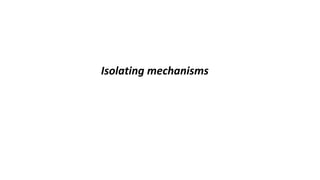The document discusses isolating mechanisms that prevent interbreeding between populations, leading to speciation. There are two main types: geographical isolation, which involves physical barriers, and reproductive isolation, which includes various prezygotic and postzygotic barriers. The Dobzhansky-Muller model explains how genetic incompatibilities arise between diverging populations, contributing to reproductive isolation and the formation of new species.




























































